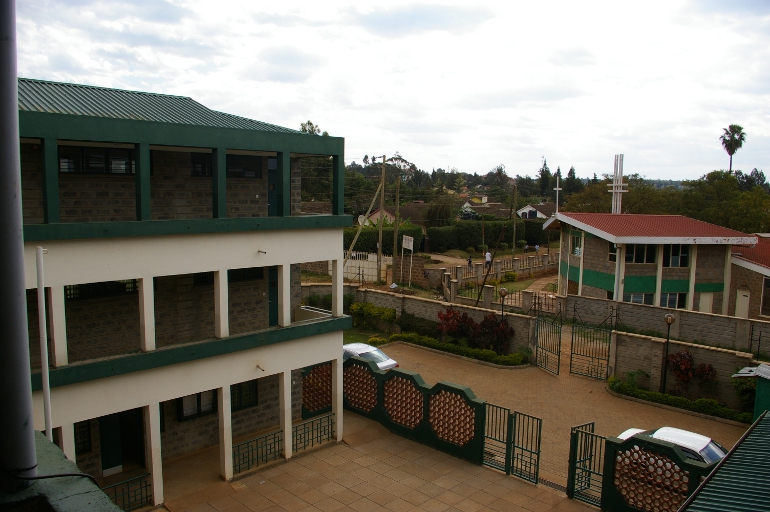
The main courtyard of St. Aloysius Gonzaga Secondary School in Nairobi's KIbera slum. (NCR photo/Joshua J. McElwee)
In a classroom at St. Al’s School here, you’ll see what you might expect: wooden desks, a chalkboard at the front, and posters giving notice of school events.
Look out a window, though, and you might be taken by surprise. Butting up against the short stone wall that outlines the school complex sits a settlement of cardboard houses with corrugated roofs.
It’s just one small section of 550 acres of such housing, where hundreds of thousands live in Nairobi’s Kibera slum, said to be Africa’s largest and one of the most notorious in the world. Residents there have no running water, sewers or electricity. And they are at incredible risk for disease, particularly HIV/AIDS.
At St. Aloysius Gonzaga Secondary School, located just off the southern edge of the slum’s formal boundary, the unique difficulties of life there have touched every student. And every student — no exceptions — has witnessed a family member succumb to the decline and death caused by AIDS.
Co-founded in 2003 by an American Jesuit and the Christian Life Community, an international movement following the spirituality of Jesuit founder St. Ignatius of Loyola, St. Al’s enrolls only HIV/AIDS orphans, offering them a free secondary education in the hopes they can then pursue college.
Co-founder Jesuit Fr. Terry Charlton, who now serves as the school’s chaplain, has lived in Nairobi since 1990. He said the decision to start the school happened quickly, when a member of Nariobi’s Christian Life Community asked him in December 2003 if it might be possible.
By January 2004, the school had enrolled 56 students in a small four-room building. In 2010, it moved to a new 420-student capacity campus, and currently serves some 280 students.
One of those students, a slim and short junior (now senior) named Thomas Osimbo, said St. Al’s has inspired him to become an engineer. He said his role model is Kenyan magnate Eddy Njoroge, CEO of KenGen, Kenya’s state-owned power company.
“I believe one day I will become an engineer, that’s what I’m working for,” Osimbo said as he sat in Charlton’s office, wearing the school’s uniform of a green polo shirt and khakis. “Every day, every night, it’s working, it’s working. One day I will achieve that goal. That’s always my dream.”
Mentioning that he lives in Kibera with his two brothers and two sisters, Osimbo said that he is the only person in his family to be able to attend high school.
Writing out the words on a notepad to be clear, he states: “That makes me special. It’s helping to shape up my future life.”
Besides classes, St. Al’s also provides lunch — on the day of NCR’s visit it was porridge, nuts, soybeans and other staples that a teacher said “would stick to the gut” — and afterschool programs focused on issues like drug education.
Beatrice Maina, who started with the school as a teacher in 2004 and became its principal in 2010, said she sees part of her responsibility as assisting in whatever basic needs she can.
“Controlling people who are in the slums is very difficult, especially when they are of that age,” she said. “Because they’re young and they need someone to tell them what to do next.”
“We’ve realized that our students have so many issues, they have so many problems,” Maina continued. “They’re people who feel so much failure because of what society has made them. They’re people who need a lot of guidance; they’re people who need a lot of counseling.”
Charlton said that each student who graduates from St. Al’s is required to volunteer for six months at a local development agency. The school, Charlton said, then promises to be available for guidance and counseling for those who can achieve enrollment at either four-year or two-year universities and colleges.
“That’s our commitment,” Charlton said. “Our commitment is, on the average, not four years, but eight years.”
A particular problem the school faces, Maina said, is reaching out to girls in the slum to make sure they are able to enroll. Because of cultural stereotypes, she said, sometimes their caregivers are not willing to enroll them.
Sometimes, she said, a boy will come to interview for one of only 70 vacancies each school year, and will say he has a sister who did very well in primary school, but was not allowed to come. A few times, Maina said, she has then been able to reach out to the girl’s caregivers and successfully enroll her too.
Charlton, who also serves as assistant provincial of the Jesuit Province of Eastern Africa, said he is concerned the school is not receiving as much fundraising as it used to. The global economic downturn, he said, has led to a dip in donations.
But he said the students he’s seen graduate from the school and then move on to life outside Kibera continue to motivate him to keep operations running.
One student he particularly remembers is David Dinda Odhiambo, a 2006 graduate who before attending the school had made money in Kibera by selling water he had carried into the slum from outside.
After graduating from St. Al’s, Charlton said, Odhiambo pursued a diploma in social work and founded a nonprofit organization, Foundation of Hope, which focuses on providing HIV/AIDS education and computer skills-building, using secondhand computers, for Kibera youth.
Mentioning that the school’s motto is “To learn, love, and serve,” Charlton said, “Obviously, he claimed the ideals for what we’re about in men and women for others.”
During a tour of the school grounds, which include a small chapel decorated with a simple icon of a young St. Aloysius Gonzaga, Charlton stopped at the school’s health clinic.
Walking inside, he explains that all St. Al’s students receive medical and dental exams as part of enrollment, and then throughout their time with the school. Mentioning some statistics on the health of the students at the school, he says one he’s “very proud” of is that “only a very small percentage” of students test positive for HIV/AIDS.
“If you have hope for the future, you’re more careful about your behavior,” Charlton says. “These are kids that have a future.”
[Joshua J. McElwee is an NCR staff writer. His email address is jmcelwee@ncronline.org. Follow him on Twitter at twitter.com/joshjmac.]




